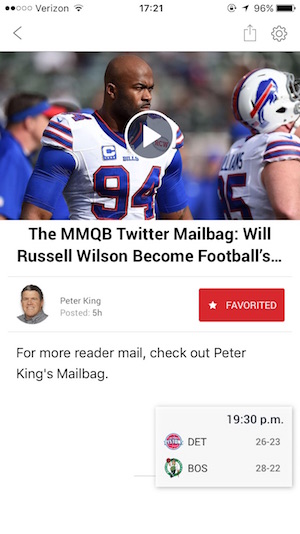
Sports Illustrated is releasing a new app Thursday that emphasizes video and prioritizes SI’s stable of well-known writers over scores and other real-time information.
 After users open a video in the SI app, they can scroll down and the video minimizes into the top left-hand corner of the screen. They can then continue to explore other sections of the app. When they’re done watching, they drag the video into into the middle of the screen to make it disappear.
After users open a video in the SI app, they can scroll down and the video minimizes into the top left-hand corner of the screen. They can then continue to explore other sections of the app. When they’re done watching, they drag the video into into the middle of the screen to make it disappear.
“Video is one of the highest priorities we have,” Sports Illustrated Group editor-in-chief Paul Fichtenbaum told me. “We wanted it fully baked into every channel on the app.”
In 2014, the magazine launched SI Wire, which is made up of 30- to 60-second news videos, and it recently added Mustard Minute, a similarly formatted video series for Extra Mustard, SI’s lifestyle and comedy section.
“That’s what sponsors are looking for,” Fichtenbaum said, regarding video. “That’s what our audience is looking for, more importantly.”
A number of other publications, such as The Washington Post and CNN, have added a similar feature onto their websites. The YouTube app also lets users shrink the video into a corner and continue browsing.
In addition to letting users multitask, this approach to video makes it easier for publishers to track video views for advertisers.
The sports app landscape is highly competitive. ESPN, Yahoo Sports, and several league-run apps are all featured in Apple’s Essential Apps collection. Last month, Facebook launched Sports Stadium, a section dedicated to live sports coverage. SI hopes its name-brand writers and editorially focused approach help separate it from other apps. (It’s not an accident that the scoreboard tab is the farthest to the right on the app.)
“Our writers are a differentiator for us,” Fichtenbaum said.
 The new app’s homepage is a personalized feed of stories based on the writers and teams that users choose to follow. Another new feature is “10 Spot,” a tab that features 10 trending stories chosen by the app’s editors, including some culture and lifestyle coverage. (The 10 Spot tab follows a trend toward finishable products, as outlets from The Skimm, with its daily newsletter, to The Economist, with its Espresso app, have tried to move away from the overwhelming, never-ending story stream.)
The new app’s homepage is a personalized feed of stories based on the writers and teams that users choose to follow. Another new feature is “10 Spot,” a tab that features 10 trending stories chosen by the app’s editors, including some culture and lifestyle coverage. (The 10 Spot tab follows a trend toward finishable products, as outlets from The Skimm, with its daily newsletter, to The Economist, with its Espresso app, have tried to move away from the overwhelming, never-ending story stream.)
The SI app also includes a more general news feed that is sortable by sport, and a separate scoreboard. Individual scoreboards can be pinned throughout the app, so you can keep tabs on the Celtics-Pistons score while also reading Peter King’s latest dispatch from the Super Bowl.
Users can choose to receive notifications for individual games and specific writers they’re interested in, so every time Tom Verducci or Grant Wahl posts a new story they’ll get a push notification.
Sports Illustrated launched its iPhone app in 2009, but that ultimately evolved into an app featuring digital editions of the weekly magazine as SI decided to focus its mobile resources elsewhere. In 2014, after SI and other Time Inc. publications spun off from Time Warner, the magazine introduced a redesigned responsive website.
SI is just the latest publisher to renew its focus on apps even as social platforms like Facebook take on outsized importance in connecting readers with content. The Times of London just released an app directed at an international audience, and Quartz plans to launch its first news app this year. The Wall Street Journal is reportedly planning a series of new apps.Sports Illustrated is also releasing a new Swimsuit app to coincide with the release of the oft-criticized but high-selling Swimsuit Issue later this month, Fichtenbaum said.
A couple of newly relevant benefits of apps are that they offer paths around mobile adblockers (the SI app has display ads throughout, plus pre-roll video ads) and enable the use of push notifications.
Quartz, for example, purposefully eschewed an app when it launched in 2012 because it wanted to reduce barriers between readers and content, but now that it’s more well-known, an app became a more attractive strategy, publisher Jay Lauf told me last month.“One of the things that changes the landscape with apps is notifications,” Lauf said. “Notifications are an increasingly popular mechanism for staying abreast of news and information and staying connected with brands. Apps certainly give you the opportunity for that.”